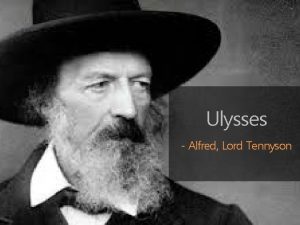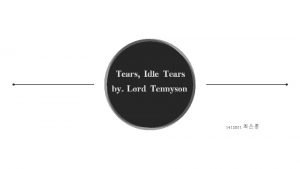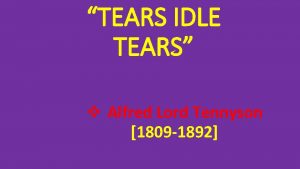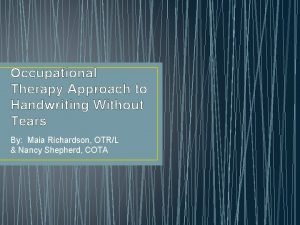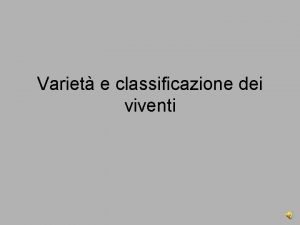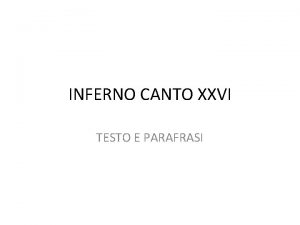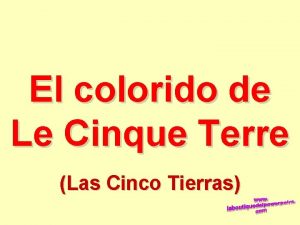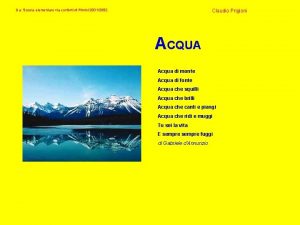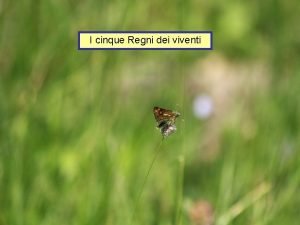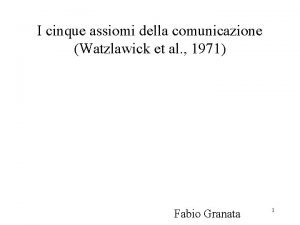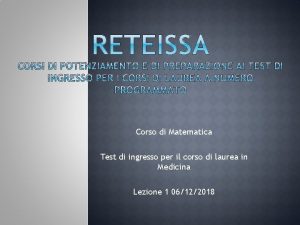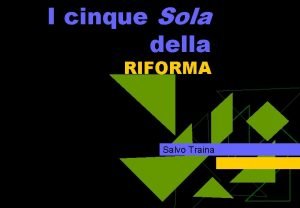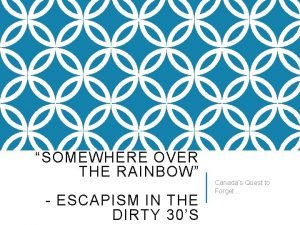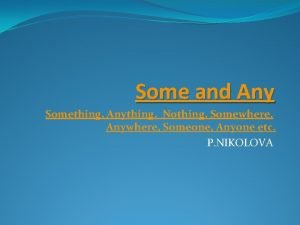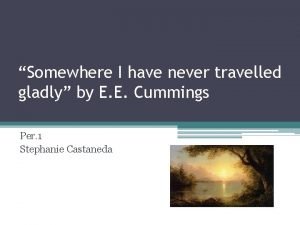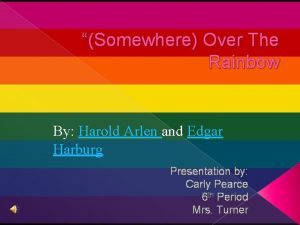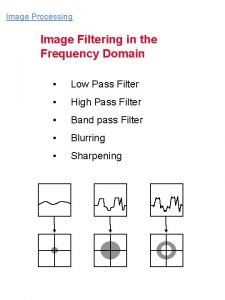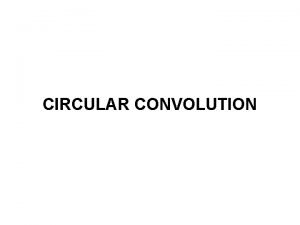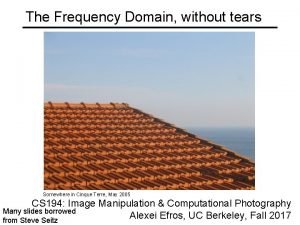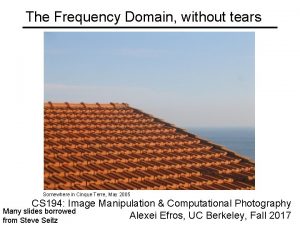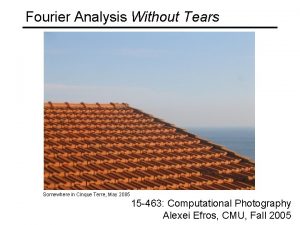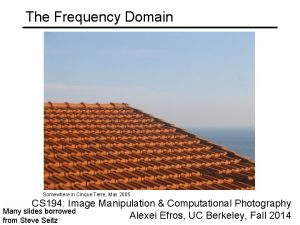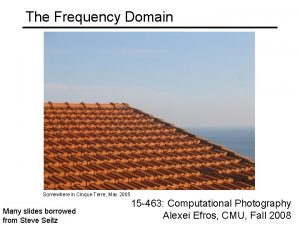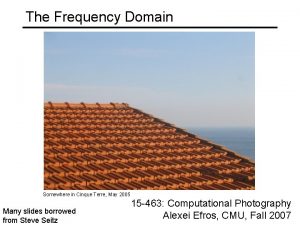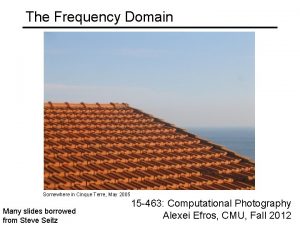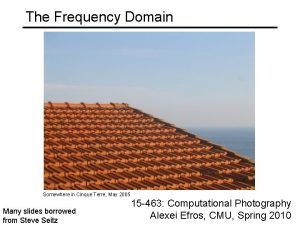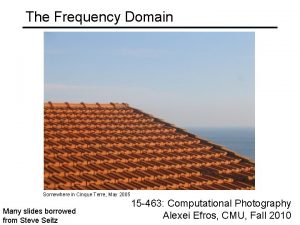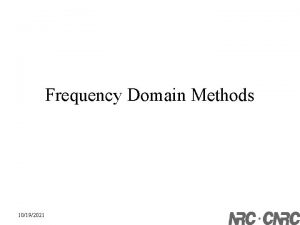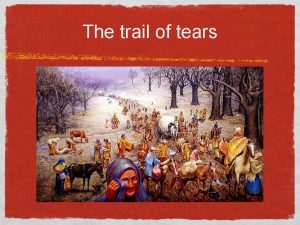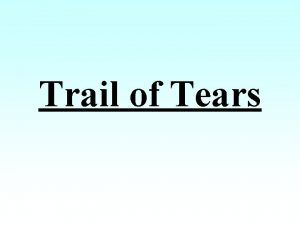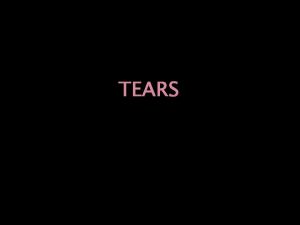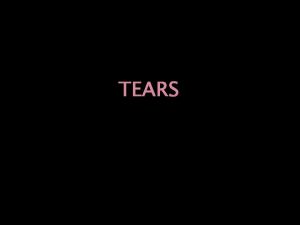The Frequency Domain without tears Somewhere in Cinque














































- Slides: 46

The Frequency Domain, without tears Somewhere in Cinque Terre, May 2005 CS 194: Intro to Computer Vision and Comp. Photo Many slides borrowed Alexei Efros, UC Berkeley, Fall 2020 from Steve Seitz

Salvador Dali “Gala Contemplating the Mediterranean Sea, which at 30 meters becomes the portrait of Abraham Lincoln”, 1976



A nice set of basis Teases away fast vs. slow changes in the image. This change of basis has a special name…

Jean Baptiste Joseph Fourier (1768 -1830). . . the manner in which the author arrives at these had crazy idea (1807): equations is not exempt of difficulties and. . . his analysis Any univariate function can be rewritten as a weighted sum of sines and cosines of different frequencies. to integrate them still leaves something to be desired on the score of generality and even rigour. Don’t believe it? • Neither did Lagrange, Laplace, Poisson and other big wigs • Not translated into English until 1878! Laplace But it’s (mostly) true! • called Fourier Series Lagrange Legendre

A sum of sines Our building block: Add enough of them to get any signal f(x) you want! How many degrees of freedom? What does each control? Which one encodes the coarse vs. fine structure of the signal?

Fourier Transform We want to understand the frequency w of our signal. So, let’s reparametrize the signal by w instead of x: f(x) Fourier Transform F(w) For every w from 0 to inf, F(w) holds the amplitude A and phase f of the corresponding sine • How can F hold both? We can always go back: F(w) Inverse Fourier Transform f(x)

Time and Frequency example : g(t) = sin(2 pf t) + (1/3)sin(2 p(3 f) t)

Time and Frequency example : g(t) = sin(2 pf t) + (1/3)sin(2 p(3 f) t) = +

Frequency Spectra example : g(t) = sin(2 pf t) + (1/3)sin(2 p(3 f) t) = +

Frequency Spectra Usually, frequency is more interesting than the phase

Frequency Spectra = = +

Frequency Spectra = = +

Frequency Spectra = = +

Frequency Spectra = = +

Frequency Spectra = = +

Frequency Spectra =

Frequency Spectra

FT: Just a change of basis M * f(x) = F(w) * . . . =

IFT: Just a change of basis M-1 * F(w) = f(x) * . . . =

Finally: Scary Math

Finally: Scary Math …not really scary: is hiding our old friend: phase can be encoded by sin/cos pair So it’s just our signal f(x) times sine at frequency w

Extension to 2 D = Image as a sum of basis images

Extension to 2 D in Matlab, check out: imagesc(log(abs(fftshift(fft 2(im)))));

Fourier analysis in images Intensity Image Fourier Image http: //sharp. bu. edu/~slehar/fourier. html#filtering

Signals can be composed + = http: //sharp. bu. edu/~slehar/fourier. html#filtering More: http: //www. cs. unm. edu/~brayer/vision/fourier. html

Man-made Scene

Can change spectrum, then reconstruct Local change in one domain, courses global change in the other

Low and High Pass filtering

The Convolution Theorem The greatest thing since sliced (banana) bread! • The Fourier transform of the convolution of two functions is the product of their Fourier transforms • The inverse Fourier transform of the product of two Fourier transforms is the convolution of the two inverse Fourier transforms • Convolution in spatial domain is equivalent to multiplication in frequency domain!

2 D convolution theorem example |F(sx, sy)| f(x, y) * h(x, y) |H(sx, sy)| g(x, y) |G(sx, sy)|

Filtering Why does the Gaussian give a nice smooth image, but the square filter give edgy artifacts? Gaussian Box filter

Fourier Transform pairs

Gaussian

Box Filter

Low-pass, Band-pass, High-pass filters low-pass: High-pass / band-pass:

Edges in images

What does blurring take away? original

What does blurring take away? smoothed (5 x 5 Gaussian)

High-Pass filter smoothed – original

Image “Sharpening” What does blurring take away? – = detail smoothed (5 x 5) original Let’s add it back: +α original = detail sharpened

Unsharp mask filter image unit impulse (identity) blurred image Gaussian Laplacian of Gaussian

application: Hybrid Images Aude Oliva & Antonio Torralba & Philippe G Schyns, SIGGRAPH 2006

Application: Hybrid Images Gaussian Filter A. Oliva, A. Torralba, P. G. Schyns, “Hybrid Images, ” SIGGRAPH 2006 Laplacian Filter unit impulse Gaussian Laplacian of Gaussian

Yestaryear’s homework (CS 194 -26: Riyaz Faizullabhoy) Prof. Jitendros Papadimalik
 Tears, idle tears
Tears, idle tears Tears idle tears 해석
Tears idle tears 해석 Tears idle tears 해석
Tears idle tears 해석 Tears idle tears
Tears idle tears Tears idle tears themes
Tears idle tears themes No tears in the writer no tears in the reader
No tears in the writer no tears in the reader Table of z transforms
Table of z transforms Z domain to frequency domain
Z domain to frequency domain Data domain fundamentals
Data domain fundamentals Roc in z transform
Roc in z transform Tiers without tears
Tiers without tears Handwriting without tears occupational therapy
Handwriting without tears occupational therapy Mat man occupational therapy
Mat man occupational therapy Cinque vie firenze
Cinque vie firenze I regni dei viventi
I regni dei viventi Czanne
Czanne Xxvi canto inferno parafrasi
Xxvi canto inferno parafrasi Il cinque maggio analisi
Il cinque maggio analisi Cinquitere
Cinquitere Osservo l'acqua con i cinque sensi
Osservo l'acqua con i cinque sensi I cinque regni degli esseri viventi
I cinque regni degli esseri viventi Cinque tesori da scoprire testo
Cinque tesori da scoprire testo Che cos'è la metacomunicazione
Che cos'è la metacomunicazione Tre fari sono visibili dal lungomare
Tre fari sono visibili dal lungomare Cinque sola
Cinque sola Joint frequency
Joint frequency How is linear frequency related to angular frequency?
How is linear frequency related to angular frequency? How to find conditional relative frequency
How to find conditional relative frequency Relative frequency bar chart
Relative frequency bar chart How to calculate relative frequency
How to calculate relative frequency Marginal frequency table
Marginal frequency table Form factor and crest factor
Form factor and crest factor The furthest distance ive travelled poem
The furthest distance ive travelled poem Somewhere somebody something
Somewhere somebody something Till we meet again vera lynn
Till we meet again vera lynn Somewhere over the rainbow judy garland
Somewhere over the rainbow judy garland Something anything nothing etc
Something anything nothing etc Wpa rainbow tables
Wpa rainbow tables Somewhere i have never travelled gladly beyond analysis
Somewhere i have never travelled gladly beyond analysis Maksim mrvica exodus
Maksim mrvica exodus But we gotta start somewhere
But we gotta start somewhere Somewhere deep in the woods
Somewhere deep in the woods There's always a bull market somewhere
There's always a bull market somewhere If u want to go fast go alone
If u want to go fast go alone Harold arlen somewhere over the rainbow
Harold arlen somewhere over the rainbow High pass filter radiology
High pass filter radiology Circular convolution meaning
Circular convolution meaning


